

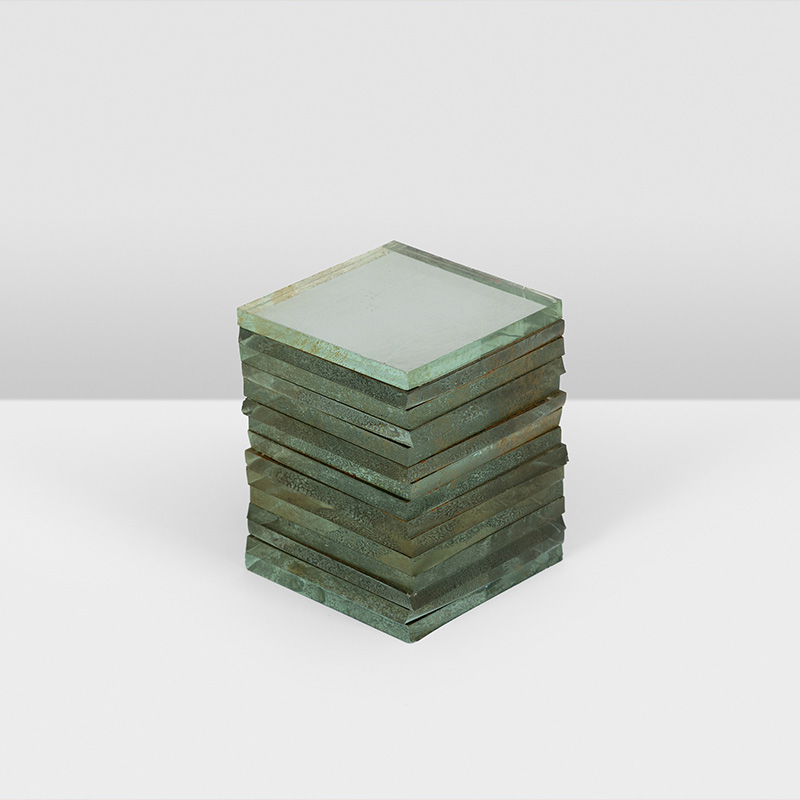
Robert Smithson (American, 1938-1973)
Untitled (n.d.)
mirrors
3½" x 2⅞" x 2⅞"
Museum Purchase through a Gift of Mr. and Mrs. Stanley Switlik
FA2022.4.2
©Holt/Smithson Foundation, Licensed by VAGA at ARS, New York.
Photo credit: Alex Yudzon
Opening June 14, 2025
In 1964, the New Jersey State Museum established a bureau to care for and collect Fine Art objects. Since then, the American-focused collection that we have here at the Museum has grown to over 12,000 artworks including painting, sculpture, and works on paper. Over the last three years, the Fine Art Bureau has made important additions to the collection that open up opportunities to explore new narratives in American art history, and New Jersey’s role in a global contemporary art world. Discover some of the latest accessions to the Fine Art collection, many of which will be on view to the public for the first time, including works by artists Robert Smithson, Cindy Sherman, Willie Cole, Mel Edwards, Nancy Cohen, and Purvis Young.

Changes in nature, whether due to naturally occurring events or actions by people, can impact environments and species. Because plants and animals are directly tied to the ecosystems in which they live, they are also affected when their habitats are impacted by change. “Ecosystems at Risk: Threatened and Endangered in New Jersey” presents some of the major ecosystems present in New Jersey and highlights the plants and animals living in them, as well as the threats they currently face. Some of the major causes of ecosystem and species loss today include climate change, invasive species, habitat loss, and pollution.
“Ecosystems at Risk” walks visitors through the major ecosystems in New Jersey - the Skylands, Piedmont, Pinelands, Delaware River, Delaware Bay, and the Atlantic Coast, and highlights the threatened and endangered species in each. From bobcats in the Skylands to Piping Plovers along the Atlantic Coast, “Ecosystems at Risk” looks at species across the state and discusses the threats they face and what you can do to help protect them. Working closely with the Department of Environmental Protection, the exhibit also showcases the research being done on these species at risk and offers hope for the long-term survival of biodiversity in New Jersey.
 National Color with battle honors, 3rd Infantry Regiment, New Jersey Volunteers, 1861
National Color with battle honors, 3rd Infantry Regiment, New Jersey Volunteers, 1861
Main Building - South Gallery, 1st floor
Get up close and personal with a rare collection of flags carried into battle by New Jersey’s Civil War soldiers and learn about our important role in the history of the War Between the States. New Jersey is one of the few states to actively display its Civil War flags, which were often returned to capital cities after the war.
The flags change periodically, allowing visitors to experience new examples from the collection.

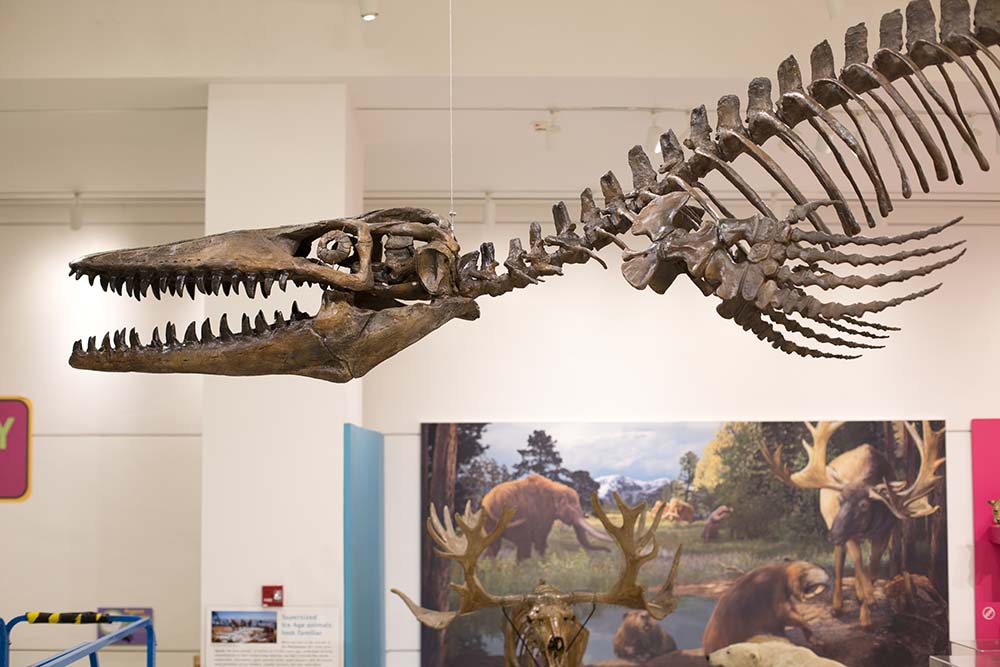
On long-term view
Main Building - 2nd floor
The exhibition presents unique fossil stories that offer intriguing clues about our ever-changing planet, how life on Earth has evolved and adapted… or gone extinct. Step back 3.5 billion years to explore the geology of New Jersey, the oldest fossils from the state and the progression of life here. Learn about the evolution of turtles, fish, mammals and birds. Meet New Jersey’s own Dryptosaurus, the world’s first known carnivorous dinosaur, reconstructed and displayed for the first time ever! Marvel at a life-sized cast of New Jersey’s state dinosaur, Hadrosaurus foulkii, and a Mosasaurus maximus – a 50-foot marine reptile discovered in southern New Jersey. These two specimens are on long-term view thanks to support from NJM Insurance Group and the New Jersey State Museum Foundation. The exhibition concludes with a look at Ice Age animals and their modern day relatives.


IMAGE CREDIT: Charles Ward (1900-62)
Study for Mural (1934) - oil on board
NJ State Museum Collection
Gift of the Friends of the New Jersey State Museum
FA1999.3
On Long-term View
Main Building - 2nd Floor Galleries
This installation highlights the diversity of voices and visions found in 19th through 21st century American art. The exhibition explores the sources of artists' inspiration and how these inspirations changed over time; how travel to Europe - and the art being made there - influenced American trends; the impact of immigrant artists bringing their own sensibilities to the US; and how world and US events (historical, political, cultural, etc.) impacted artists.
The exhibition allows visitors to see that art-making does not happen in a stylistic or ideological vacuum. Works created by academic, expressionist, folk, modernist and visionary artists will be shown together in a roughly chronological format to present the range, variety and complexity of America's fine art. In addition, important works by significant NJ artists will be highlighted within the context of American art.
The exhibition was made possible, in part, with support from the Friends of the New Jersey State Museum through the Lucille M. Paris Fund.
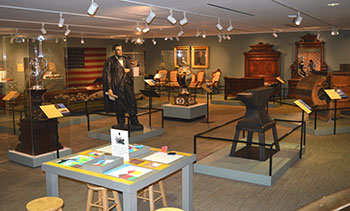
View of the Pretty Big Things gallery.
On Long-term View
Main Building - 3rd Floor
A 1,400-pound anvil made by Trenton's Fisher & Norris Eagle Anvil Works. An iron pot used to render whale blubber on the Jersey Shore. A hand-carved statue of the tallest American president. A "grandfather" clock made by the first African-American clockmaker. A grandiose Dutch immigrant wardrobe crafted in the 18th century.
What do these five historical artifacts have in common? They are all pretty big things. Using a non-traditional approach that eschews strict chronology, this educational exhibit consisting of compelling artifacts and hands-on activities for families takes visitors on an eclectic journey into unknown stories of New Jersey history using some of the "biggest" artifacts from the museum's Cultural History collection.
Do you know which American presidents have historical ties to our state? Can you name the symbols found on the Great Seal of the State of New Jersey? Did you ever wonder why New Jersey is called the Garden State? Do you know the difference between locally-made furniture types known as the linen press, the kast, and the chest-on-chest?
Can you name a New Jersey industry that was represented at the famous 1876 Centennial International Exposition in Philadelphia? Come to the State Museum in order to learn the answers to these big questions of New Jersey history and to celebrate the rich historic heritage of our state.
Pretty Big Things: Stories of New Jersey History is the long-term core exhibition for the New Jersey State Museum's Cultural History Bureau, a diverse collection of historical artifacts documenting the history of everyday life in New Jersey from colonial times through the present day.
The exhibition was made possible, in part, with support from the Friends of the New Jersey State Museum through the Lucille M. Paris Fund.
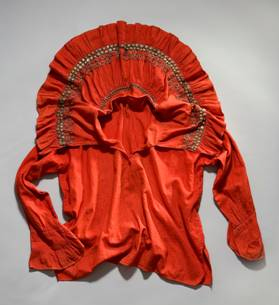
IMAGE CREDIT: Delaware Woman's Blouse with Silver Brooches (c.1810-80)
Cotton, cotton thread, silver and dye
Collected by anthropologist Frank G. Speck
from the daughter of Chief Wooden Buffalo
Gift of Frank G. Speck
AE 3202
On Long-term View
Main Building - Lower Level Gallery
This exhibition offers visitors a glimpse into the lives of the Delaware Indians over a two hundred year time span. From the 1740s to the 1890s, many of New Jersey's Indians moved out of the state ahead of the ever-expanding non-Indian population. Artist and chronicler of American Indians, George Catlin (1796-1872), noted as early as 1832 that the Delaware were among the most relocated Indians in the United States. This exhibition tells the story of these migrations.
In the late 1800s and into the 1900s, the Indians that remained in New Jersey survived by adapting to a market economy. They developed handcraft industries which produced items desired by non-Indian settlers. The Indians produced baskets and other woven items such as mats and brooms, as well as carved wooden pieces such as mortars and shovels.
The descendents of the Delaware Indians who left New Jersey, as well as those who stayed, continue to follow and adapt their cultural and religious traditions, thus preserving them for future generations and sharing them with all other cultures.
The objects on view, which date from the late 1700s to the early 1900s, include a woman's blouse with silver brooches, splint baskets, a wooden shovel, a leather pipe bag decorated with glass beads, children's moccasins and a child's basket.
The exhibition was made possible through funding support provided by PSEG Foundation, with additional generous support provided by the Friends of the New Jersey State Museum.
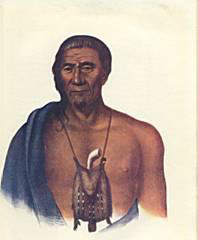
IMAGE CREDIT: After Gustavus Hesselius Tish-Co-Han
A Delaware Chief (c.1837-1844)
Hand-colored lithograph from "The McKenney-Hall Portrait Gallery of American Indians"
Published by J.T. Bowen, Philadelphia
New Jersey State Museum Collection
Museum Purchase
FA1980.49.17
On long-term view
Main Building - Lower Level
The exhibition provides a view of the seventeenth-century Dutch, Swedish and English competition to start colonies within what is today New Jersey and to develop a successful fur trade with the Indians who were living here.
The visitor is given the opportunity to view this exciting period of history through Native American and European objects produced during this fierce competition. The impact of the Europeans' arrival and eventual settlement on the lifestyle of the Indian inhabitants is also presented through early documents and historic maps and drawings. Artifacts on display include a rare dugout canoe along with examples of seventeenth-century Indian fishing equipment and domestic and personal items drawn from the Museum's extensive Native American archaeological collections. English- and Dutch-made seventeenth-century trade goods recovered from excavations at Indian sites include metal axes and hoes, glass beads, a rare brass kettle, gun parts, and white clay smoking pipes.
A selection of tools and ornaments the Indians made from broken brass kettles is also in the exhibition, along with a reconstruction of how wampum (small shell beads) was made by the Indians. Historic wampum beads are displayed and the importance of the beads in the fur trade is presented through historic accounts. The exhibition includes the earliest images of the Indians of the area drawn by European colonists and the earliest maps showing sites of Indian settlements in the seventeenth-century.
The exhibition was funded by the Friends of the New Jersey State Museum through a generous grant from the Estate of Paul Stillman, Wachovia Bank, Executor.
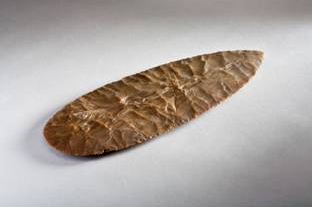
IMAGE CREDIT: Leaf-Shaped Biface Blade
Gloucester County, NJ
Gift of Rutgers University, Special Collections
AE2010.11.906
On long-term view
Main Building - Lower Level
New Jersey's Original People: Interpreting the Archaeological Collection tells the story of New Jersey's native people and their cultural adaptation to an ever-changing climate. The term "Original People" is one translation of the word Lenni Lenape, the name of New Jersey's native peoples.
From shortly after the glaciers receded 13,000 years ago up to the 17th century, native people used the natural resources in their own environment, and later brought in from other areas, to help them survive. Their ingenuity and ability to adapt is demonstrated through the display and interpretation of artifacts from the Museum's extensive archaeological collections. Scholars recognize the Museum's holdings of more than 2.4 million archaeological objects as the definitive systematic research collection for the study of the prehistory of New Jersey and the Middle Atlantic region. Visitors will see the evolution of tools and other artifact types and uses, illustrating how native peoples adapted to environmental change. Through projection, hands-on and intuitive interactives, this exhibit highlights the many aspects of Native American life and speaks to the ingenuity of New Jersey's "original people."
An adjacent gallery, "The Science of Archaeology," also provides visitors with an opportunity to encounter an "active" dig site. The "Science of Archaeology" gallery also serves as a classroom, orienting visitors on the science behind archaeological excavations and investigations. This installation explores how archaeologists, through the ongoing collection and analysis of artifacts, interpret the stories of prehistoric life in the Garden State to educate and inform current and future residents.
The exhibition was made possible through lead funding support provided by the PSEG Foundation, with additional generous support provided by the Friends of the New Jersey State Museum.
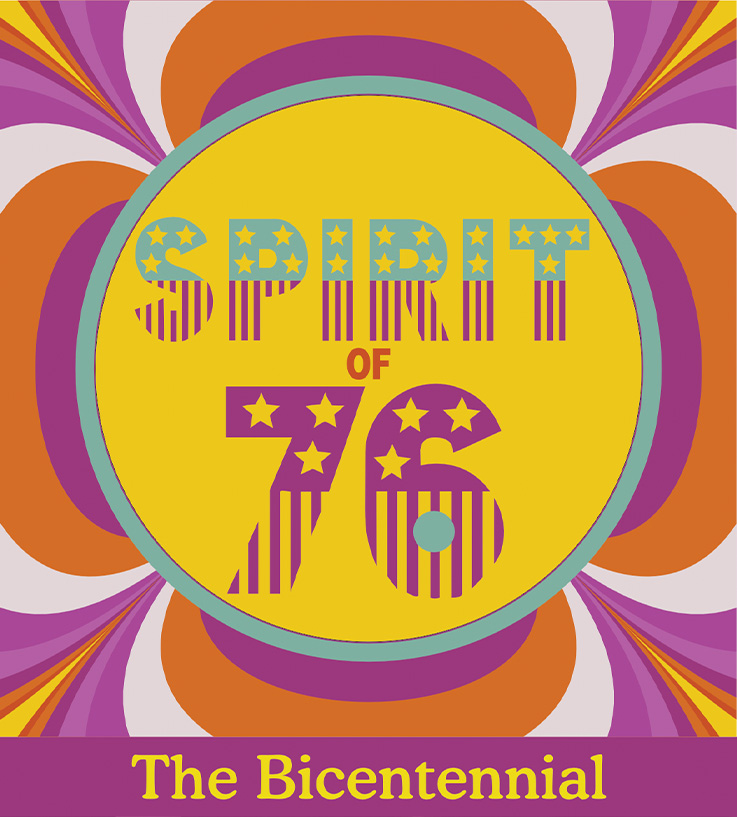
Opening February 14, 2026
Polyester pants and platform shoes; pinball machines and Parliament Funkadelic; petroleum crises and presidential pandemonium. That’s right – the State Museum is going back to the Seventies for this upcoming exhibition. In 1976, Americans looked to heal the wounds wrought by the tumultuous 1960s and put aside their many differences in a widespread celebration of the nation’s 200th birthday. Drawing exclusively from the State Museum’s own collections, Spirit of ‘76: The Bicentennial showcases an assortment of never-before-exhibited artifacts and artworks produced fifty years ago as part of the energy and excitement of the Bicentennial. Highlights include masterpieces of porcelain by the Cybis studio of Trenton, silkscreen and lithographic prints by New Jersey-native Jacob Lawrence and other American artists from the Kent Bicentennial Portfolio and a handcrafted cotton album quilt made by a group of first-time fiber artists from Princeton. Can you dig it?
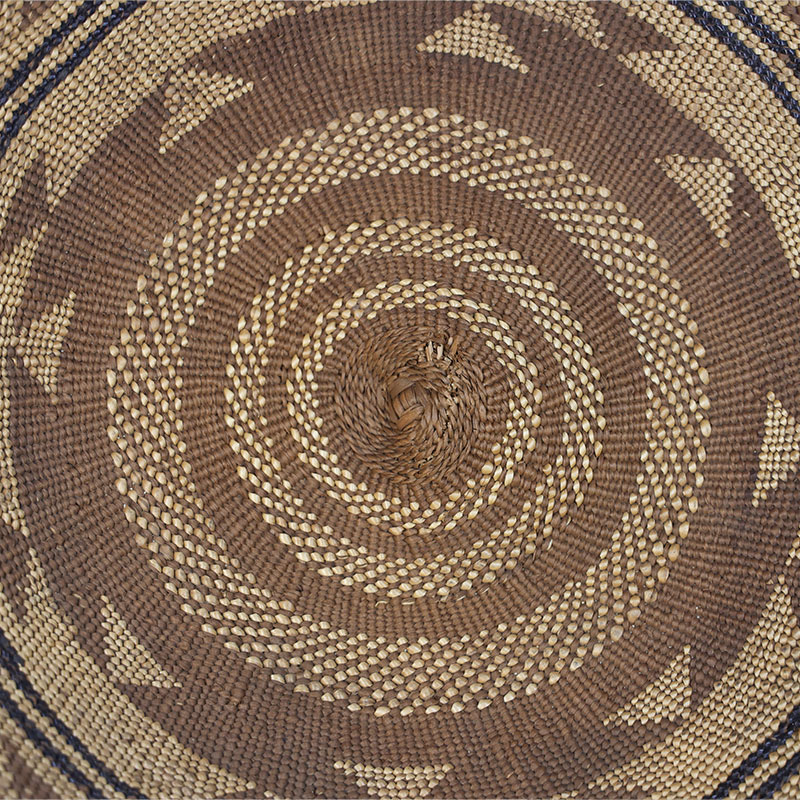
May 4, 2024 – May 11, 2025
The use of bark is global and ubiquitous from prehistoric times to today. Indigenous communities all over the world harvest bark as a source of food, medicine, everyday objects and works of art. Highlighting objects from the Museum’s Ethnographic collection, explore items from the Pacific Northwest, South America, Pacific Islands and our local Eastern Woodlands area. Learn more about how bark is harvested and crafted and how these ancient traditions continue today.
Activities for all ages are available on select weekends throughout the run of the exhibit.
All text in this exhibit is also available in Spanish.
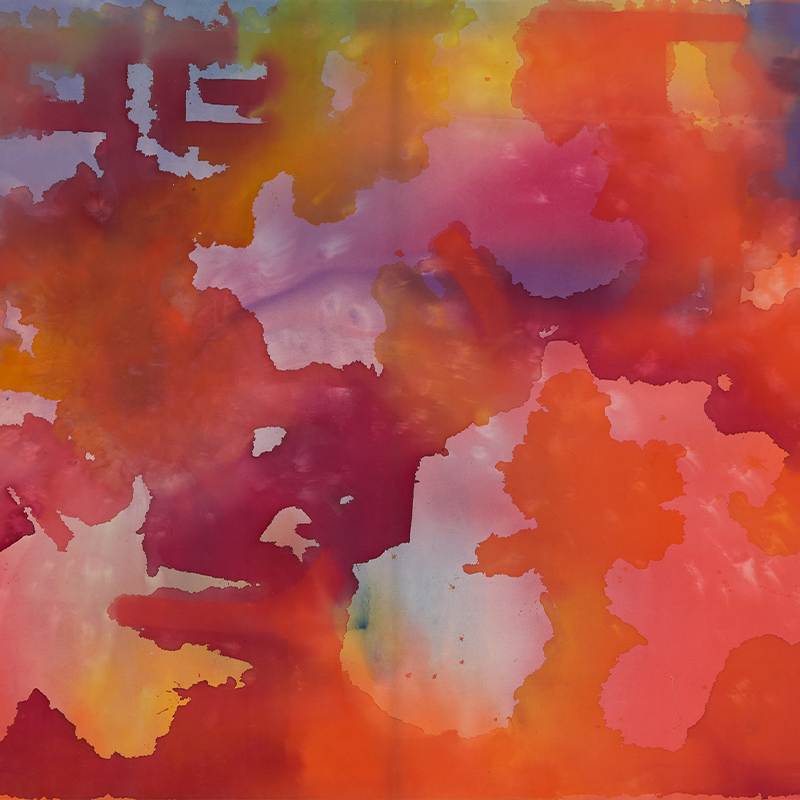
Closing March 16
Born in Salinas, California, to a Filipino father and Shawnee mother, Robert Duran (1938–2005) arrived in New York in the early 1960s via San Francisco, where he soon became part of the artistic milieu associated with Bykert Gallery. Originally a sculptor, Duran and his approach to painting offer an alternative to both the hard-edge geometric abstraction and minimalism that dominated much of the ‘60s and ‘70s in New York. Duran’s acrylic wash surfaces and “color shapes,” as critic Carter Ratcliff called them, at times resemble petroglyphs, and at others take on cartographic or even geological qualities.
Despite a critically successful career in the New York art world, Duran moved around 1980 with his family to Hillsdale, New Jersey, where he privately continued to develop his painting style. Through the works in this exhibition, visitors will be able to trace the arc of Duran’s evolutions and experiments in painting, drawing, and watercolor from roughly 1967 to the late 1990s. Much of what we know about Duran is limited to exhibition history and anecdotes from friends, family, and acquaintances who can only begin to flesh out certain contours of the artist’s life, often leaving more questions than answers. This exhibition seeks to reintroduce this artist to the public primarily through the most significant record of his life available to us: his paintings and works on paper.
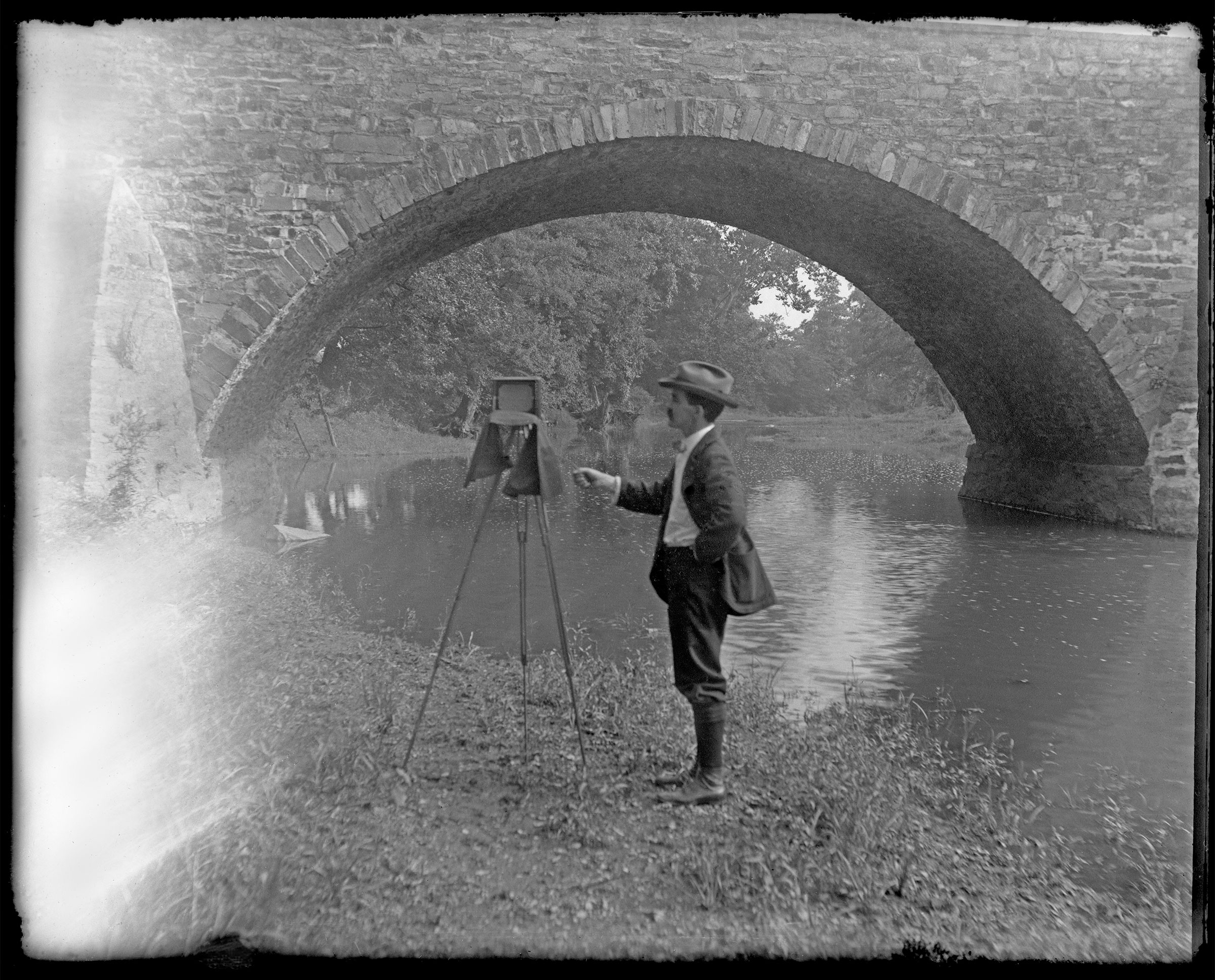
February 3, 2024 - September 15, 2024
Experience New Jersey history through a recently discovered archive of photographic negatives that once belonged to a prolific, but long-forgotten, local photographer.
“Discovering Grant Castner” celebrates one New Jerseyan’s passion for photography - from the 1890s through the 1910s, and is curated from the State Museum’s extensive collection of the photographer’s original negatives.
In 2019, the New Jersey State Museum received a donation of more than 1,200 glass plate negatives. The plates preserve pinpoint moments of everyday life in New Jersey at the turn of the 20th century, snapshots of our collective past. They belonged to Grant Castner (1863-1941), an amateur photographer born in Belvidere (Warren County) who later lived and worked here in Trenton.
The 200 images featured in the exhibition reflect Caster’s artistic talent and illustrate numerous aspects of New Jersey history, from close-up portraits of family and friends to the marvels of turn-of-the-century transportation, to the flurry of excitement and activity at the famed Inter-state fair in Hamilton Township.
Further subjects include:
Visit this exhibition to discover more about the life and works of Grant Castner and experience the full breadth of his talent as it transports you back in time to the New Jersey of our ancestors.
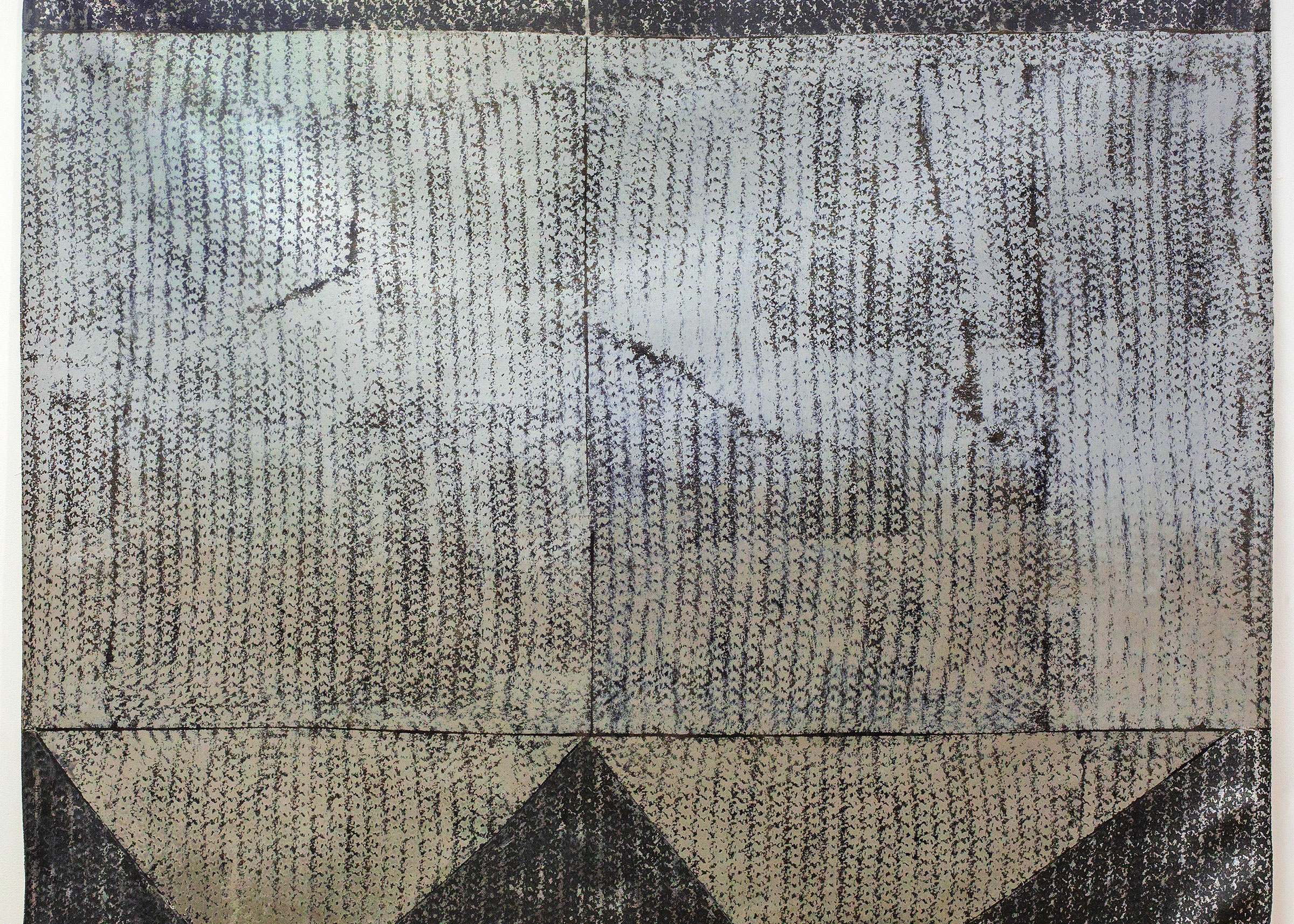 Caroline Burton: Way Finding
Caroline Burton: Way Finding
State I (of Being, NJSM), 2022
acrylic on canvas
72.5 x 61 in.
Courtesy of the artist
September 23, 2023 – March 31, 2024
Since 1984, the New Jersey Artist Series at the New Jersey State Museum has highlighted artists living and working in the state, and established the Museum’s crucial involvement with the world of contemporary art in New Jersey and beyond. We are pleased to announce that Caroline Burton will be the next artist featured in the exhibition series.
Caroline Burton is a process-driven artist, who draws on architectural forms, nature, and elements of chance for inspiration. Burton moves fluidly between painting, drawing, printmaking and sculpture, often combining techniques in a practice that invites unconventional materials. This New Jersey Artist series exhibition will feature some of the artist’s most recent work, from 2020 to the present, including a series based on the Brutalist architecture of the State Museum building.
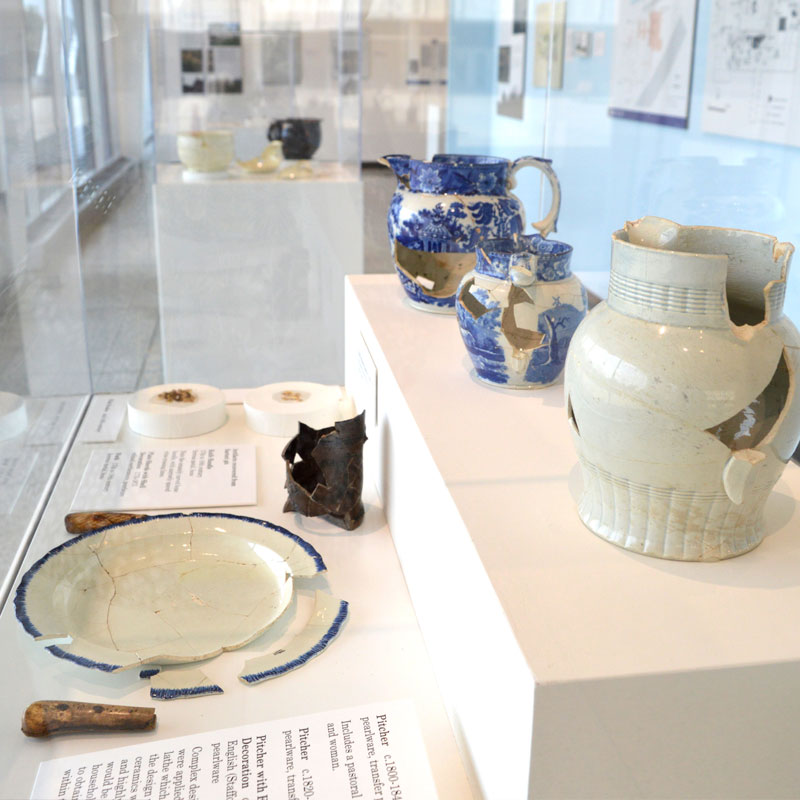
“History Beneath Our Feet: Archaeology of a Capital City,” focusing on the long history of human activity in Trenton, New Jersey as told through the lens of archaeology. The exhibition will be on view in the Museum’s main floor gallery. Visitors will discover the importance of archaeology to preserving the past and how excavations at ten locations within Trenton have helped inform our knowledge of human occupation and activities in the area, going back to prehistoric times. Stories that have been lost to time reemerge through artifacts on view, including pottery sherds that illuminated the existence of a long-forgotten local potter; thousands of artifacts that marked a previously unknown Indigenous people’s site; beads that may have belonged to enslaved people; a hollowed-out wooden log that served as Trenton’s water system in the 19th century, and more. Among the archaeological sites explored are the New Jersey State House, Petty’s Run, the Trent House and the Old Barracks Museum.
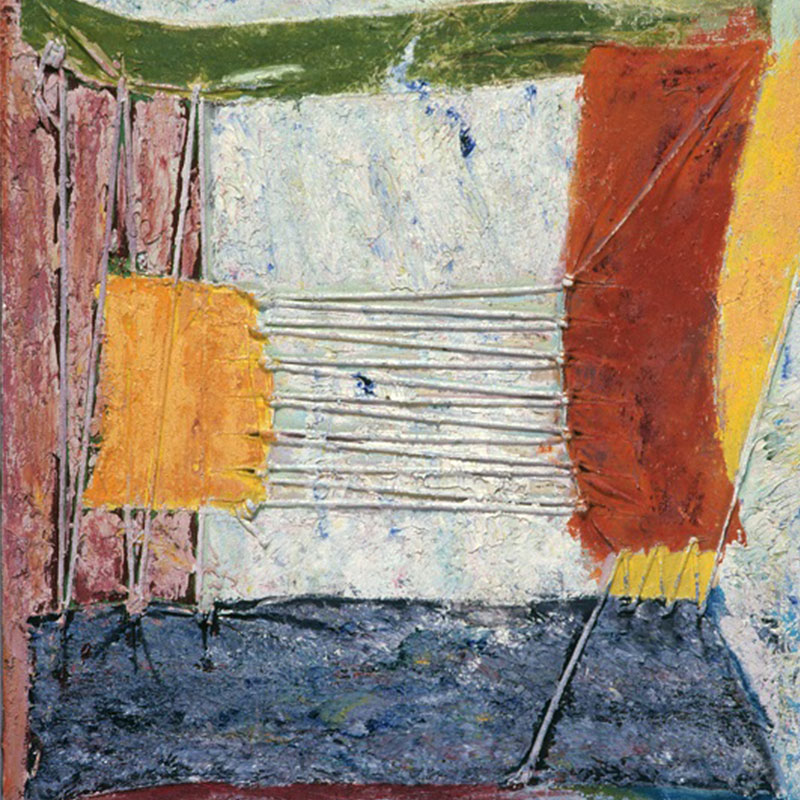
Joe Overstreet
FIRE AND ICE (1991)
oil and collage on canvas
Gift of the artist
On view through August 27, 2023
“Beyond the Tangible: Non-objective Abstraction from the Collection” is a new exhibition of 26 non-objective abstract works by 22 artists from the Fine Art collection. The exhibition can be seen in the Museum’s 2nd floor gallery and features works created by American artists since the late 1930s. “Beyond the Tangible” is on view through August 27, 2023.
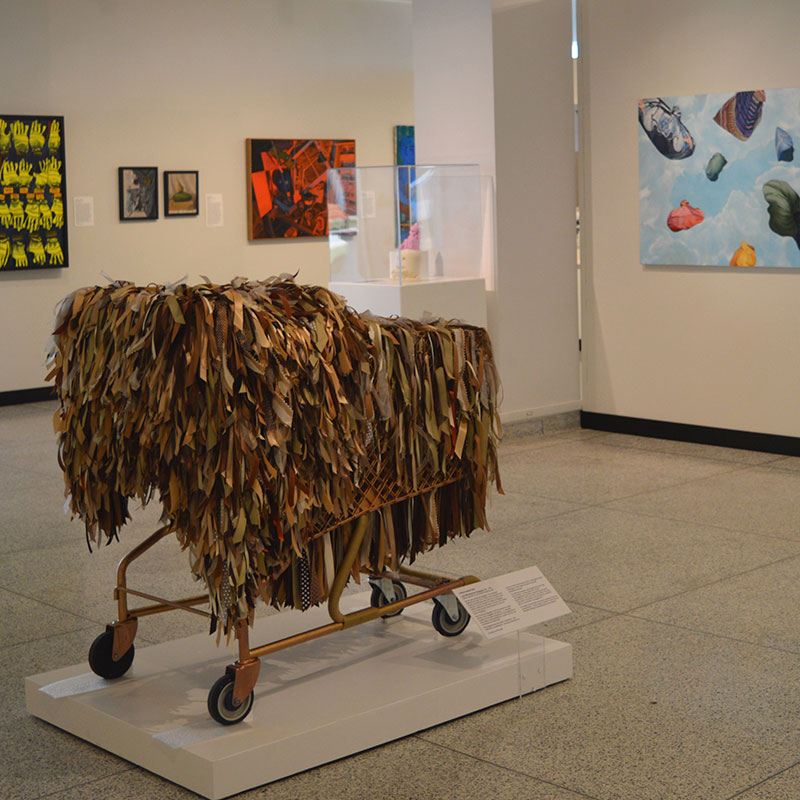
New Jersey is home to a diverse and robust artistic community; the New Jersey Arts Annual exhibition highlights the work of visual artists and craftspeople from around the state. This year’s exhibition theme is “Reemergence.” Artists, like most New Jerseyans, are taking steps to reemerge into an altered landscape. The ongoing COVID-19 pandemic, political and ideological polarization, and a collective reckoning with systemic racism remain critical to achieving the country’s promise. One hundred twenty-seven works by 95 artists were selected for inclusion in the exhibition. The complete list of artists. The New Jersey Arts Annual: Reemergence is a project of the New Jersey State Council on the Arts and the New Jersey State Museum. At the New Jersey State Museum, the exhibition is also supported by the New Jersey State Museum Foundation.
NJ Arts Annual Artist Talks: https://www.youtube.com/channel/UCNFj4CbXUFux_WZQUEi6JSA
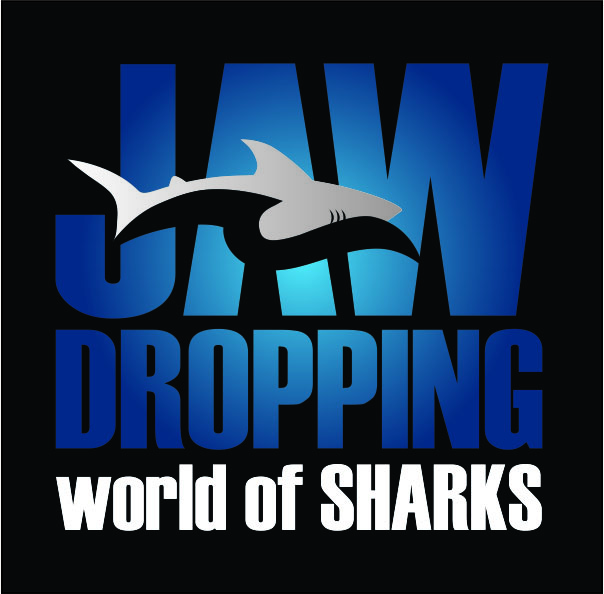
Sharks and their relatives share a 400-million-year history and have a diverse family tree. They inhabit the world’s oceans, rivers and estuaries evoking fear and mystery. But much this fear comes from a lack of understanding about sharks and their habitats. This exhibition dispels some of the myths and misunderstandings about sharks and their relatives by exploring their biology, fossil record, conservation and cultural significance. Specimens and artifacts from the New Jersey State Museum collections will be on display to demonstrate the truly jaw-dropping world of sharks!
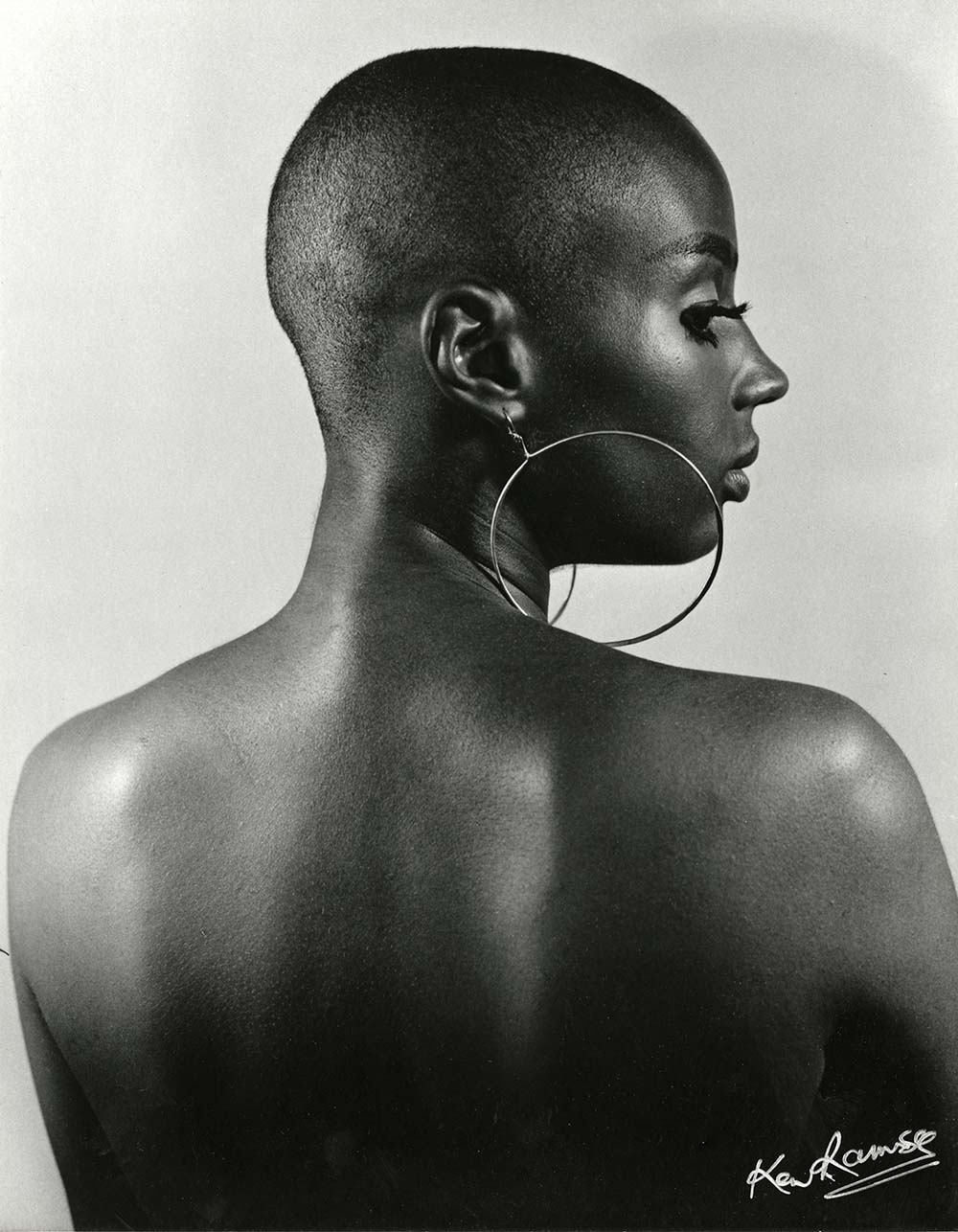 Ken Ramsay 1935-2008
Ken Ramsay 1935-2008
Susan Taylor, as Model c.1970s
gelatin silver print
Courtesy of Susan Taylor
January 29, 2022 – May 22, 2022
The exhibition explores the contested ways in which African and African American beauty have been represented in historical and contemporary contexts. Throughout the Western history of art and image-making, the relationship between beauty and art has become increasingly complex within contemporary art and popular culture. This touring exhibition was organized by the Department of Photography & Imaging at New York University, Tisch School of the Arts, and curated by Deborah Willis, PhD, University Professor and Chair of the Department. At the New Jersey State Museum, the exhibition has been made possible by the Lucille M. Paris Fund of the New Jersey State Museum Foundation.

IMAGE CREDIT: JAR, (Before 1941) Pueblo
Acoma Pueblo, New Mexico
clay, polychrome
Gift of Dr. Lancelot Ely
AE7122A
The New Jersey State Museum is one of the oldest state museums in the nation, and was the first of its kind to be established with education at the heart of its mission. In the beginning, the Museum’s focus was on natural history, but today, the Museum includes important collections in Natural History, as well as Archaeology & Ethnography, Cultural History and Fine Art. This exhibition offers visitors a glimpse into the diversity of the collections which number well over 2,000,000 specimens, artifacts and objects.
Today, the Museum’s remains committed to education through the research and preservation of its collections. The Museum continues to expand and now includes well over 2 million specimens, artifacts and objects. These treasures are held in trust for the people of New Jersey to learn about our history, celebrate our place in the world and inform our future.

Jan. 4, 2020 – Mar. 6, 2022
They occupy our forests, fields, parks, beaches, farms, backyards and even our homes. Indeed, birds are everywhere. But many New Jerseyans remain largely unaware of the profound natural and cultural significance of these ubiquitous avian creatures.
This exhibition will bring together a wide assortment of artifacts and specimens to explore two concepts about our fine feathered friends – their status as an important ecological mainstay and their historical role as a design-inspiring force – or muse – for New Jersey artisans in the decorative arts.
A Virtual version of the exhibition can be view here: www.flickr.com/photos/njstatemuseum/collections/72157714167946541/
Find your feathered friends with this mini bird guide!